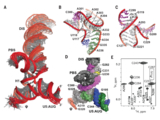Professor Michael Summers, chemistry and biochemistry, has focused much of his career on advancing the understanding of the structure of HIV. In a new article in Science, his research group presents their work on determining the structure and function of the part of HIV that directs the packaging of copies of the virus as it prepares to infect new cells. Scientists have been struggling to understand this aspect of the virus for 30 years, making this a highly significant advancement in this research area.
All viruses spread from one cell to another by exploiting the normal behaviors of infected cells. Infected cells are used to make copies of a virus, which is then packaged into containers that are sent out to infect other cells. Each type of virus has its own genetic code, stored as long chains. Depending on the sequence, each chain folds onto itself in a predetermined shape. This shape helps to drive the function of the virus. All viruses spread in similar ways, but each virus is unique enough in its approach that treatments or resistance to one virus are rarely useful in avoiding a different virus.
By better understanding how HIV goes about packaging copies of itself, it becomes possible to develop better treatments that target this stage of the infection process and prevent infections from spreading. This latest publication of the Summers research group, coauthored by several current UMBC students and alumni who are now researchers at institutions around the country, is a particularly significant step in this direction.
Tags:
Posted: May 29, 2015, 11:20 AM
